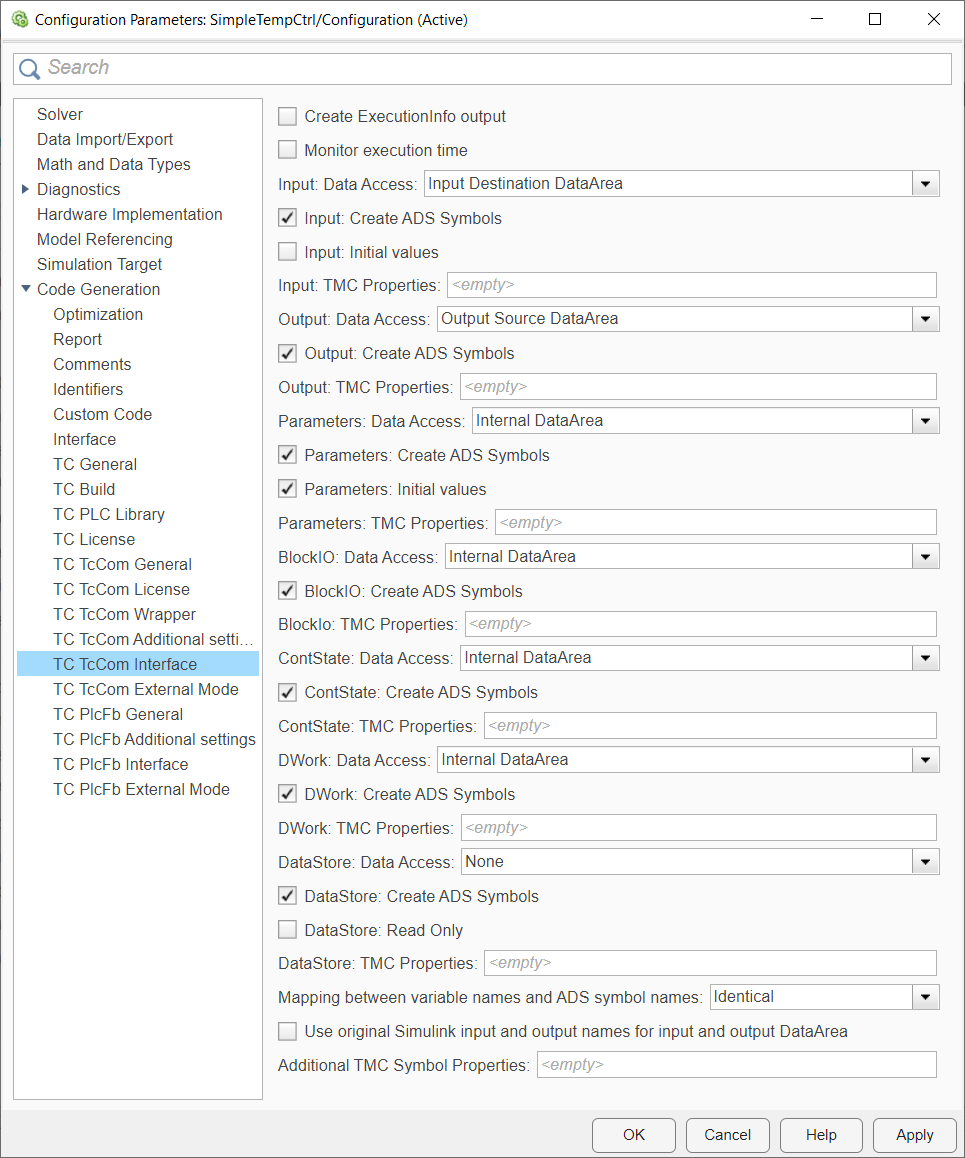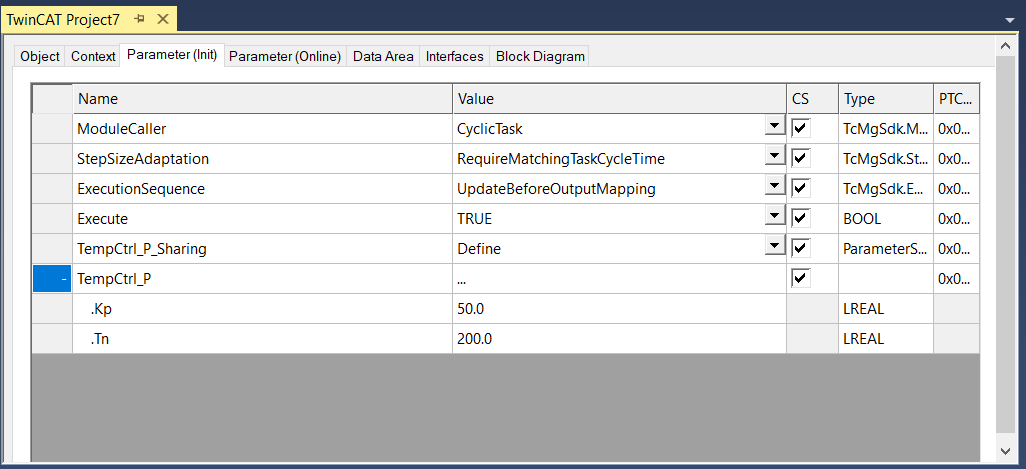Configuration of data access to data of a TcCOM object
In the TC TcCom Interface area, you configure the way in which data of certain variable groups can be accessed. ADS access and the process image type can be configured as required. These settings affect how the variables in a group are linked with other process images in the TwinCAT development environment, and how they can exchange data.
Variable groups
Depending on the Simulink® model, there are several groups of internal variables in addition to the input and output variables.
The following groups can be configured:
Group | Description | Naming of the DataArea (default) | Naming of the DataArea (“classic” option) |
|---|---|---|---|
Input | Model inputs | <ModelName>_U | Input |
Output | Model outputs | <ModelName>_Y | Output |
BlockIO | Global output signals of Simulink® blocks: internal signals for which a “test point” has been defined. | <ModelName>_B | BlockIO |
Parameter | Model-specific parameters: Parameters of Simulink® blocks that are tunable. | <ModelName>_P | Model parameters |
ContState | Continuous state variables | <ModelName>_X | ContStates |
DWork | Time-discrete state variables | <ModelName>_DW | DWork |
DataStore | Data Store Memory | <ModelName>_DW_<DataStoreName> | <ModelName>_DW_<DataStoreName> |
Under TC TcCom Interface, the option Mapping between variable names and ADS symbols can be used to influence the naming of the DataAreas. By default, they are given the same name as the associated C++ variable. This is specified by Simulink® Coder™. With the “Classic” setting, the names are abbreviated to that of the variable group, as known from earlier TE1400 versions 1.2.x. The inputs are then combined, for example, in the DataArea “Input” and not in “<ModelName>_U”.
 | TcCOM with multiple task contexts If a TcCOM is created that has more than one task context (see Multitask, Concurrent Execution and OpenMP), the DataAreas are automatically separated. There are several inputs or Dwork DataAreas, for example. |
Configuration interface in Simulink®
Switch to Advanced mode to make the following parameters visible.
TwinCAT.ModuleGenerator.Settings.Change('ConfigurationLevel', 'Advanced')
The Data Access can be defined individually for each variable group named above. Selection options for DataAreas and module parameters are summarized in the following table:
Data Access | Access via ADS | Access via mapping | Access via Data Pointer |
|---|---|---|---|
None | No | No | No |
Module parameters | Yes | No | No |
Input Destination DataArea | Yes | Yes (with Output Source) | Yes |
Output Source DataArea | Yes | Yes (with Input Destination) | Yes |
Internal DataArea | Yes | No | No |
Standard DataArea | Yes | No | Yes |
Retain Source DataArea | Yes | Yes (with Retain Handler) | No |
Unlike DataAreas, Module parameters are not intended for cyclic (process) data exchange with other modules or I/Os. They are generally read or written asynchronously, e.g. via ADS. The parameters on the Parameters (Init) tab have an initial value that can be configured in the project and is written when the TcCOM instance is started. The parameters on Parameter (Online) on the other hand, have no configurable initial value and are typically used to monitor internal states.

DataAreas can be found on the TcCOM instance on the DataArea tab. The exact type of the DataArea is also displayed here. Internal DataAreas are not created as process data image in the development environment.

Properties of the parameterization
The access via ADS is usually ReadOnly. Only the Inputs and Parameters groups can also be written via ADS.
Independently of this, it is possible to set for each group whether ADS symbol information (Create ADS Symbols) should be created for the respective group. If no ADS symbol information is available, the data can only be accessed by ADS via IndexGroup and IndexOffset.
Via the option “Input: Initial values” you get an entry under “Parameter (Init)” in addition to the DataArea (for the cyclic data exchange). This way initial values for inputs can be realized. These values apply if the corresponding inputs have not been linked. Without these parameters, unlinked input values are always 0.
Via the option “Parameter: Initial values”, the parameters of the Simulink® model are also created as module parameters (structure <ModelName>_P) in addition to the DataArea setting.
 | Special case: DataArea for model parameters If the code interface is set to Reusable function (default), then no DataArea is created for model parameters, since the parameters are kept global for this case and thus shared between multiple instances. If “Parameter: Initial values” is selected, the parameter “<ModelParameterName>_Sharing” is created in addition to the entry for the model parameters at Parameter (Init). This parameter can only be set to “Define” for an instance of this TcCOM module class. All further instances must use “Inherit”. Since all instances share the parameters in this case, they all work with the parameter set in the “Definer”. The model parameter settings of the other instances are ignored. |
Monitor Execution Time: Creates a module parameter at Parameter (Online) and in the block diagram (right side). The execution time of the TcCOM can be read via this parameter. The measurement is updated with each call of the TcCOM, so that, for example, the execution time can be tracked precisely for each call via the TwinCAT Scope.
Create ExecutionInfo output: Creates an additional Output Source DataArea with information about the module call, see Exception handling.
DataStores: Variables from a Data Store Memory Block are stored in DWork by default. You can create an additional addressing of these variables when you create a DataArea for DataStores. No DataArea is created by default. For an example, see Shared memory between TcCOM instances.
Further Descriptions:
- Structure of a TcCOM: Description of the TcCOM properties
- Properties of DataAreas
- Using a RetainDataArea with the NOV-RAM: RetainDataArea
- You can use DataPointer e.g. via the TC Module Input and TC Module Output blocks, see Shared memory between TcCOM instances.